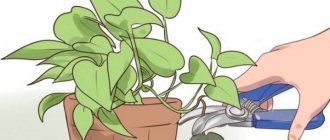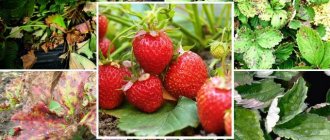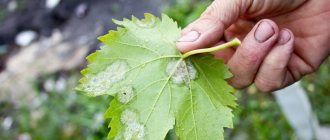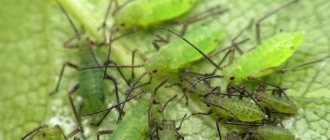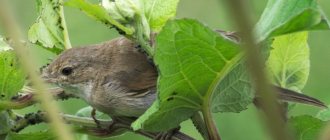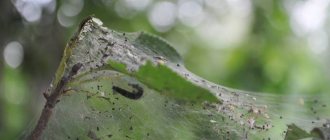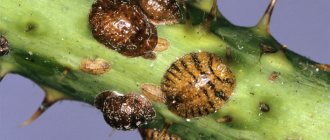Description, what it looks like and what harm it causes?
It is difficult to detect aphids when they have just begun to settle in a plant due to the small size of the insect. The tiny body has a round or drop-shaped shape. Depending on the variety, the color of the integument can vary from pale, almost transparent, to black. Most often, white aphids are found on house flowers.
The insect is extremely prolific. The ability for parthenogenesis (virgin reproduction) and rapid maturation of larvae allows the number of pests to increase hundreds of times in just a short time. A colony of aphids on a plant looks like many small specks. Only upon careful examination can you see that they are moving. Most of them are wingless individuals. The winged generation is born from fertilized eggs. Their task is to expand their habitat.
Appearance
The pest feeds on plant sap, piercing leaves or young shoots with its proboscis. The flower begins to wither and may die. Honeydew, which is excreted by insects, coats the leaves with a sticky coating. Sooty fungus quickly develops on it.
Description and characteristics of the pest
White aphid, or scientifically phylloxera, is a microscopic pest that can lead to the death of a vineyard. It was first discovered in Russia in 1879, but it turned out that it was brought from the American states. Now it is most common in the Stavropol and Krasnodar territories, as well as in the Rostov region.
There are more than four thousand varieties of aphids, more than a quarter of them are common in Russian regions. Each of them lives primarily in one crop, but with a significant increase in population it can spread to others. Ants contribute to this: they feed on aphid honeydew.
White aphids parasitize grape crops. First it spreads to the root system, and with serious signs of the disease it moves up to the leaves. Reproduction occurs 10 days after the female lays eggs.
An individual white aphid does not exceed 1 millimeter in size, but the population is noticeable due to its large concentration. Summer residents notice it by the appearance of growths - galls with eggs. The body is particularly ovoid, slightly elongated, and has three limbs.
It is necessary to fight white aphids immediately after their appearance is noticed. Otherwise, it quickly migrates to leaves and fruits. As a result, the leaves fall off and the fruits stop growing. If further measures are not taken, the winegrowing crop will simply die.
Types of aphids
Scientists count several thousand species of these insects, but the so-called house aphids, which include several varieties, live in pots with indoor plants. They are distinguished by the color of their covers:
- White aphids are most often found on indoor plants. Sometimes it is called shaggy, since the light brown body of the insect is covered with whitish waxy fluff.
- The black cherry aphid is a pest of stone fruit crops, but also reproduces on indoor plants.
- Yellow, blood and some other varieties of aphids prefer to settle in the garden plot, but once inside the house they take root well in flower pots.
- The green greenhouse aphid often lays eggs in the soil of indoor plants. It parasitizes many flowers, without any particular preferences.
Mechanical methods of processing plants
If signs of aphid influence are noticed on young foliage (twisting, thickening or brown color), then such plates should be immediately torn off and burned. Among the advantages of this method, one can note the 100% elimination of aphids and the fact that new shoots quickly grow in place of torn leaves,
Important!
White aphids are very dangerous for indoor plants, as they can destroy all the flowers in the house. If you cannot cope with the problem yourself using folk remedies, it is recommended to purchase ready-made chemicals.
Reasons for appearance
Aphids appear on indoor plants for one reason - there is food for them here. This is a fairly unpretentious insect; it is not very bothered by humidity levels and temperature fluctuations. An adult can live at +100C for up to 60 days. However, they need warm and dry air to reproduce quickly.
Attention! The most commonly affected by pests are violets, primroses, begonias, orchids and cyclamens. But pests rarely appear on palm trees and ficus trees, since it is difficult for them to pierce the thick skin of their leaves.
Does not like aphids and geraniums. It repels insects with its scent. Moreover, this indoor flower protects nearby plants from pests.
Ways to enter the house
There are several ways a pest can enter an apartment. It is impossible to completely protect against aphid attacks on house plants, but precautions in most cases will protect the house from pests.
Aphids enter the house as follows:
- The winged female flies into an open window or window, attracted by the scent of flowers. Mostly residents of the lower floors suffer from this.
- May be accidentally carried on clothes and shoes. Pets that are outdoors sometimes bring in pests on their fur. The insect is so small that it is impossible to see and shake it off.
- When purchasing a diseased plant. For prevention purposes, the newly acquired flower should be kept separately from others for about a month. During this time, the aphid, if present, will manifest itself.
- Plant soil may be contaminated with pest larvae. Therefore, immediately after purchase, it is calcined in the oven at high temperature and only then used.
- Ants can bring aphids into the house, which in every possible way contribute to the spread of these insects. If they appear in an apartment, it is necessary to carry out comprehensive control of both pests.
Infected plant
How do aphids spread?
Introduced with planting material and soil, the “underground inhabitants” begin to reproduce: asexual females lay eggs in the roots so that the hatched larvae can suck the juice out of them, gnaw passages and parasitize on the plant. Some of the juveniles rise to the surface, and this is how the transition occurs to stage 2, the gall stage.
It is possible that the life cycle goes in a different direction: the aphid descends underground to continue reproducing there. In any case, without taking effective preventive measures, the plant may die.
Signs of a houseplant being affected by aphids
Initially, it is difficult to notice aphids on indoor flowers. It reveals itself only when the colony becomes significant. You can tell that a plant has been attacked by pests by looking at the condition of the house flowers. They wither, the leaves become deformed, curling into a tube. A sticky honeydew appears on them, which the insect secretes. The buds begin to wither without blooming.
Black spots can sometimes be seen on plants. This is when a sooty fungus began to develop, the carrier of which is the aphid that appears on the plant.
When aphids appear, measures to destroy them must be taken urgently. The insect reproduces quickly and in a short time can destroy the flower completely.
Prevention of aphids
To prevent an aphid attack from becoming an unexpected surprise, you should take preventive measures in advance to prevent its appearance and reproduction:
- The first stage occurs in the autumn season, when the harvest is carried out. To reduce the number of aphid eggs laid for the winter, it is necessary to collect and destroy all plant remains, and dig up the soil to a depth of 10-15 cm.
- In the spring, in the area allocated for vegetable gardens and tomato plantings, it is recommended to treat with Karbofos to destroy the eggs and larvae of aphids.
- When planting tomatoes, plants with a pungent odor are planted between the rows to repel them: dill, marigolds, celery, etc.
- Throughout the season, regularly inspect the lower parts of the leaves and stems of plants in order to detect in time when white, black or green aphids appear on them, especially in greenhouse plantings.
- In areas near tomato plantings, it is recommended to remove all anthills, the inhabitants of which like to breed aphids for their food.
A successful result in pest control depends on how quickly measures are taken to destroy them after aphids appear on tomatoes, because this insect is capable of multiplying at a rapid pace and destroying garden plants in a matter of days.
Sources:
https://gidfermer.com/sadovodstvo/borba-s-vreditelyami/chernaya-tlya-na-pomidorax-kak-borotsya.html https://fermer.blog/bok/ogorod/tomaty/vyraschivanie-tomatov/obrabotka-tomatov /1163-tlja-na-pomidorah.html https://notklop.ru/tlya/izbavitsya-ot-tli/tlya-na-pomidorah/
How to get rid of aphids on plants
You can get rid of aphids on indoor flowers using both pesticides and traditional methods. If pests are found on only one plant, then by first placing it in quarantine, you can destroy the insects with decoctions and infusions prepared from improvised means. When the colony of aphids has spread to all the flowers, insecticides are indispensable.
Mechanical method
At home, at the first signs of infection, you can try to get rid of aphids using mechanical methods:
- Remove aphids with water under strong pressure, after covering the ground with film.
- Scotch tape is used to remove pests from flowers. The sticky side is pressed against the infected leaf, thus collecting aphids.
- You can try to crush small bugs with your hands, after wearing rubber gloves.
- A more drastic method is to prune all affected parts of the plant. After that, the flower is treated with a soap solution, spraying it every other day until the aphids completely disappear.
Biological methods
The range of biological methods for getting rid of white aphids in the house is limited, since natural enemies are excluded from the arsenal of remedies.
For indoor plants against aphids, biological products are produced that effectively fight insects. Fitoverm is popular. Flowers need to be processed twice, with breaks of 2-3 weeks. Experts also recommend Entobacterin, which contains bacterial spores that have a detrimental effect on pests. The best option is achieved at an ambient temperature above +250C.
Some flowers help get rid of aphids because they repel parasites with their scent. Flower growers claim that aphids do not live on geraniums, marigolds, and mint. They protect neighboring plants from attack by pests.
Geranium
Folk remedies for aphids
Folk remedies are effective against aphids when the pest colony is still small. They are environmentally friendly and safe for people and pets:
- Flowers can be sprayed with a solution of laundry soap. It quickly kills insects. To prepare, take 1 bar of soap per 10 liters of water. The treatment is repeated every other day until the pests completely disappear.
- A remedy such as ammonia also helps fight aphids on indoor plants. 10 ml of ammonia is stirred in 2 liters of water. The resulting solution should be sprayed on both sides of the flower leaves.
- Infusions of garlic, onions, and citrus peels will repel pests. They are used for preventive purposes for all plants after the infected flower has been quarantined.
- Spraying with Coca-Cola diluted with water in a ratio of 2:7 will help quickly get rid of small insects. The product is not recommended for use on young plants.
- A proven method is an infusion of wood ash. 1 glass per 10 liters of water is enough to treat all the plants in the house.
Chemicals
If the infestation is severe, nothing more than pesticides will help remove aphids from indoor plants. When choosing what to treat flowers with, you need to remember that insects develop immunity to poisons. Therefore, medications need to be changed.
On indoor flowers, a remedy such as Aktara, which causes paralysis in the pest and leads to death, will help fight aphids. The drug has a systemic effect, that is, it not only kills the insect upon direct contact, but also makes the plant sap poisonous. It is also used for preventive purposes.
Actellik is also used to combat aphids. The product is very strong and destroys insects already during spraying, so it is recommended for use when plants are highly infested.
The drug Inta-Vir has a detrimental effect only on adults, so treatment must be carried out at least three times with a break of two weeks.
Before spraying, it is better to take the flowers out onto the balcony or terrace.
Rating of aphids
After analyzing expert opinions and reviews from experienced buyers, we have prepared a review of effective products with a wide range of capabilities against aphids and other garden parasites. We assessed each applicant on a group of criteria in order to correctly rank them according to rating positions:
- Release form: sprays, powder mixtures, capsules, emulsions, concentrates;
- Composition – synthetic, natural substances, their properties, likelihood of addiction;
- Operating principle: repelling, defeating, protecting, complex systemic effect;
- Directions for use: dilution with water, spraying, pouring into the ground;
- Purpose – what insects it works against, narrow or broad spectrum;
- Compatibility - can it be alternated or applied simultaneously with analogues;
- Speed of action - how quickly the death of parasites occurs;
- Protection - how long the plants are not re-infected;
- Cost-effectiveness – how much area of territory is treated;
- Safety – toxicity, impact on crops, humans, animals.
We analyzed several hundred reviews from gardeners and gardeners, where they shared their experience of using insecticides, fungicides, miticides, and biological products. Thanks to this information, it was possible to weed out ineffective lineups and identify the strengths and weaknesses of the nominees.

